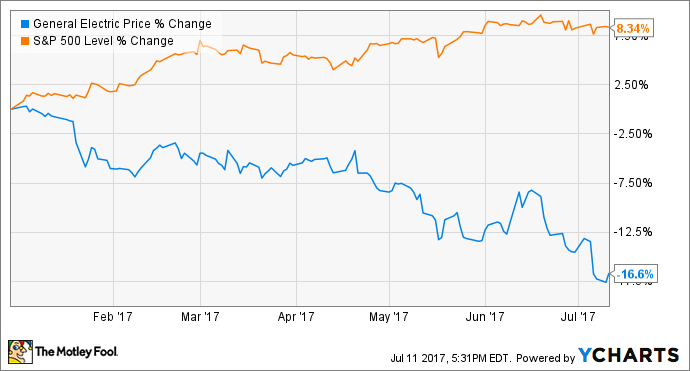General Electric Company's (GE 2.84%) stock is down 16.6% year to date as I write. However, declines in good stocks can create buying opportunities for enterprising investors. So let's look at nine reasons stockholders can expect the market to look more favorably on this stock in the future.
1. A new CEO
As readers already know, incoming CEO John Flannery has promised to make a thorough review of the business portfolio and look at the company's guidance in the fall. This plan raises the prospect of a value-creating restructuring of the company -- one that wouldn't have been made under the previous leadership of Jeff Immelt.
2. Earnings set to grow
While the analyst community continues to cast doubt on Immelt's target of $2 of operating earnings per share in 2018, the analyst consensus is for $1.89. In other words, their forecasts still imply a pretty healthy growth rate. In fact, analysts call for 10% growth in 2017, to $1.64, followed by a 15% increase in 2018. If the market can forget about the $2 target, or if Flannery drops the target, then it might become clearer that GE's underlying growth is still good.
3. Cost cuts
GE has significant structural cost cuts on the way. For example, management expects to reduce structural costs by around $1 billion in 2017 and 2018, respectively. To put that figure into context, operating income was around $14 billion in 2016.
4. Equipment margin
Equipment margin fell to just 1% in 2016, compared with the historical run rate of around 5%. A large part of the reason for the drop is the increase in production of two major and relatively new products -- the LEAP aircraft engine and the H-turbine. However, as production ramps up, GE expects unit production costs to fall significantly in the future. For example, unit cost production of the LEAP engine is expected to decline by 15% in 2017, and by 10% for the H-turbine.

A LEAP jet engine in testing. Image source: GE Reports.
As a consequence of these actions, operating margin is expected to expand by 100 basis points in 2017 and 2018. Moreover, the cost-cutting measures are likely to be lasting.
5 and 6. Baker Hughes and Alstom
GE is in the process of integrating two major acquisitions. The following chart shows just how important the addition of Alstom's energy assets has been to GE's power equipment orders.

Data source: General Electric Company presentations. First quarter of 2017 does not break out Alstom orders separately, as they are now included in the overall figures.
The ability to combine Alstom's expertise in steam power with GE's gas-turbine capability, whereby a power plant uses both to produce more electricity from the same amount used in a solely gas turbine-powered plant, brings long-term benefits.
Meanwhile, the Baker Hughes Incorporated (BHI +0.00%) deal is expected to be accretive to earnings by $0.04 in 2018 and $0.08 by 2020. All told, both deals promise long-term earnings potential.
7 and 8. Digital solutions: investment and implementation
GE's investment in digital solutions is expected to pay off in future years. GE's Predix solution, a platform-as-a-service cloud solution designed to help customers capture and analyze industrial data, will drive adoption of GE's equipment and services as customers find they can better utilize their assets. It's a key value-add for GE to offer customers.
Moreover, implementing GE's digital solutions into Baker Hughes and Alstom products is a key rationale for the deals and will create growth synergies for GE. Rivals such as ABB Ltd. (ABB +0.62%) have followed suit by increasing their investment in digital solutions.
9. Oil and gas spending
The point is somewhat more subjective. There's little doubt that the merger of GE's oil and gas business with Baker Hughes has increased the company's exposure to oil and gas capital spending, and Immelt aggressively positioned GE in the sector with a raft of acquisitions since 2010.
Accepting the U.S. rig count as a proxy for energy capital spending, it's clear that spending is largely correlated to oil prices, and few can have great confidence in the direction of energy prices.
US rig count data by YCharts
No matter. The current rig count trend remains favorable, and if oil prices continue to at least stabilize, then GE looks set to benefit.
Looking ahead
All told, if the market can forget about the near-term earnings guidance and focus on the underlying improvements in the business, then there's a strong case for GE's stock price to start to turn around -- but it's going to take some ongoing operational execution, particularly with regard to acquisitions and the company's digital strategy, plus favorable energy prices. Meanwhile, all eyes will be on the results of Flannery's review when it's released in the fall. Despite the fall in stock price this year, there's still a lot to like about GE.








